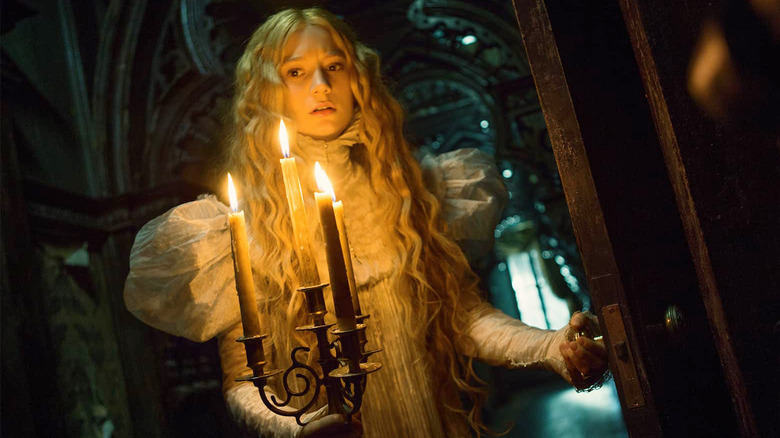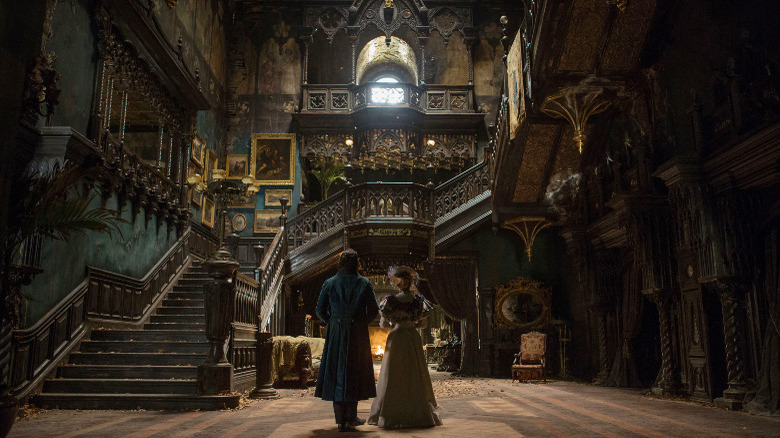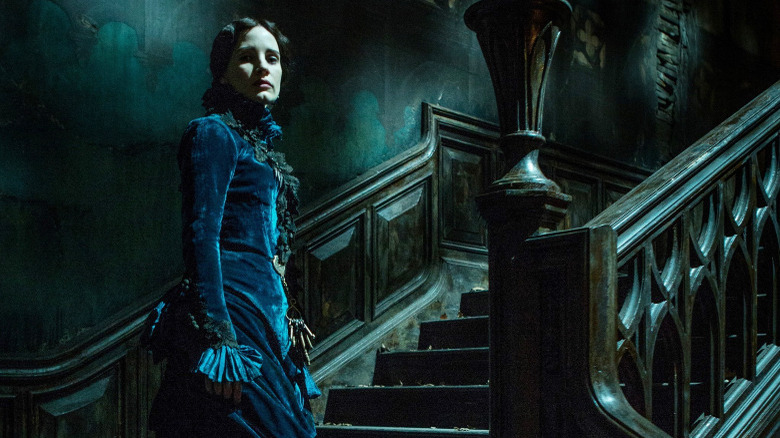Guillermo Del Toro Had To Walk A Ratings Tightrope To Get Crimson Peak Made
"Crimson Peak" is not just Guillermo del Toro's love letter to the classic gothic romance writing of Emily Brontë and Henry James, but it's also an homage to lavishing gothic horror movies (themselves based on famous books) like Robert Wise's "The Haunting" and Jack Clayton's "The Innocents," both of which are personal favorites of del Toro's. But where those films expressed violence and sexual content through subtext and implication, del Toro's movie was free to depict its brutality, kink, and twisted acts of love in graphic detail. "Crimson Peak" is similarly explicit in the way it reveals that ghosts are real in its universe, rather than hinting at the existence of the supernatural without ever confirming it the way those spooky dramas do.
After releasing "The Shape of Water" in 2017, del Toro was able to secure $60 million to go make another throwback genre piece in the form of the carnival noir-thriller "Nightmare Alley." Even at the time, it was the kind of R-rated, esoteric, adult thriller that you only really got to direct when your last movie won the Best Picture Oscar and grossed nearly 10 times what it cost at the box office. Those types of mid-budget theatrical films have become even rarer in 2022 and are more likely to head directly to streaming, should they happen at all. Of course, it's not like del Toro had an easy time convincing his financier, Legendary Pictures, to sign off on his equally-costly R-rated vision for 2015's "Crimson Peak," either.
'I wanted the R'
Much of "Crimson Peak" is set in the Sharpe family's decaying mansion in Cumberland, England, in the late 19th century. It's an eerie, haunting remnant of the Sharpes' lost fortunes and dark past. Leaves and snow fall into the main hall through a gaping hole in the roof. Pipes creak and moan behind the interior walls of the manor as moths eat away at what remains of the fading wallpaper. The visual symbolism isn't lost on anyone familiar with the tropes of gothic storytelling, but the movie's primary set piece is also just really cool to look at and take in. That's because it's a real three-and-a-half-story structure adorned with props, and not just a few practical elements with a huge green-screen backdrop.
As he explained to the Los Angeles Times in July 2015 (a few months before the film hit theaters), del Toro always intended to bring the Shapes' home to life this way, even before securing the movie's rating:
"We had the discussion. Legendary loved the screenplay, and they said, 'We want to do it, but this is one budget if it's PG-13 (a bigger budget if it's PG-13), and this is the budget if it's R.' And I wanted the luxurious part of the movie, but I wanted the R. So I was tiptoeing into balancing that it stayed an R, but it was luxurious enough to be an old-fashioned production. It feels like a throwback to the big productions of Hollywood, in a way."
For as much as del Toro aimed for this throwback vibe (which the LA Times described as a "Cinemascope feel"), he also drew from the traditions of British and Italian horror:
"The American part is all in golds and tobaccos, so it has a beautiful, rich, noble type of color palette. And then it goes to almost Technicolor, Mario Bava, Hammer films into the old world, into the house of Allerdale Hall, a.k.a. Crimson Peak."
It looked great on the big screen, too
I can confirm that "Crimson Peak" was as gorgeous to behold as del Toro hoped for, having seen the movie at an IMAX screening on its opening Friday night on October 16, 2015. Every detail and color on display was enriched by the format, as was its shocking, horrific violence and swoon-worthy romance. The film would have been just as effective watered-down to a PG-13 in many ways thanks to its sheer craftsmanship. At the same time, del Toro is always deliberate in the way he uses gore, language, and sexual content to serve the themes or character motivations in his movies, and "Crimson Peak" is no exception. That is to say, it definitely would have lost something had del Toro not stuck to his guns and gone full-R.
When push came to shove, "Crimson Peak" was a box office flop (I can attest that my own screening played to a noticeably small crowd), but that's no shock. Even with a PG-13 rating, del Toro's macabre tale of ghosts — both metaphorical and otherwise — would have still been far too niche to have broad appeal in the modern movie landscape. It's since amassed more of a cult fanbase thanks to streaming and the home media market, where viewers can appreciate the filmmaker's splendid vision in all its bloody, horny glory.


